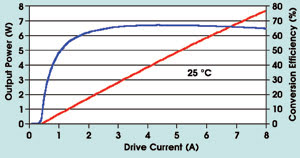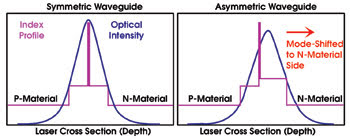Matthew Peters, JDS Uniphase Corp.
As part of our ongoing involvement in the development of potentially industry-changing advanced technology, we at JDS Uniphase Corp. have been working since January 2004 on the Defense Advanced Research Projects Agency’s Super High Efficiency Diode Sources (SHEDS) program. We believe that the goal of combining single-emitter lasers into a 360-W bar with 80 percent electrical efficiency at 50 °C in a tight wavelength band around 939 nm is possible using a radically asymmetric wavelength-stabilized design. Currently, lasers using this technology achieve efficiency as high as 67 percent at 25 °C (Figure 1).

Figure 1. Radically asymmetric wavelength-stabilized lasers have achieved efficiencies approaching 70 percent.
Our team has been developing a highly efficient laser diode based on a proprietary commercial 6390 laser diode. The design, which currently achieves about 60 percent efficiency at 25 °C, is being optimized to reach the agency’s more stringent goals. Once this is accomplished, we will begin to integrate single emitters into a bar configuration.
The 6390 meets SHEDS’ power and brightness requirements without modification. The design features a 100-μm-aperture, single-emitter diode whose ~3-nm lasing line can be anywhere between 910 and 980 nm, depending on composition, and whose CW output is 6.5 W. The reliability approaches 1 million hours mean time between failures under typical operating conditions. The wavelength target for the company’s team is 939 nm, with 90 percent of the power within a 2-nm band.
The team conducted tests on thousands of single-emitter lasers under various conditions to understand the sources of power loss. Based on these tests, it concluded that power loss at 50 °C is divided fairly evenly among waste voltage, waste current and optical loss.
• Waste voltage is a combination of the turn-on voltages of the metal-to-semiconductor contact, various heterojunction interfaces in the laser and the parasitic resistances of wire bonds, metal layers and semiconductor layers.
• Waste current is divided into the threshold current needed to reach the required active region gain and the leakage current, which is commonly referred to as the active region injection efficiency.
• Optical loss includes both internal loss within the laser, usually from free-carrier semiconductor absorption, and external loss, such as light lost out the back facet or emitted outside the far-field angle required for the particular application.
Taking into account the effects of elevated temperature — such as the increase of current threshold and leakage and the decrease in electrical resistance — and the outcome of the tests has yielded positive results. JDS Uniphase now can accurately model the 6390 structure and proposed SHEDS structures to match the experimental results.
Some initial steps one might take to boost efficiency already have been exploited. For example, optical loss in the passive layers outside the laser diode’s quantum well is primarily the result of free-carrier absorption and, thus, is proportional to the doping concentration. Decreasing the doping concentration can reduce optical loss, but this leads to an increase in the series resistance of the laser diode, which diminishes the electrical efficiency.
Instead, we have turned to radically asymmetric wavelength-stabilized technology to reduce free-carrier absorption and to eventually achieve the goal of 80 percent efficiency.
The approach is based on the fact that free-carrier absorption by holes in the P-type material is greater than the corresponding absorption by electrons in the N-type. The diode’s asymmetric index profile pushes the optical mode away from the P-material side of the laser diode and into the N-material, thereby minimizing the free-carrier absorption (Figure 2).

Figure 2. The asymmetric waveguide forces the optical mode to move into the N-type material, where free-carrier absorption is less than in the P-type.
Increasing the refractive index on the N-material side pulls the mode into that side of the device, so the amount of light propagating in the P-material can be made very small, decreasing the internal optical loss. At the same time, the thickness of the P-material can be slimmed, leading to a significant reduction of the thermal and electrical resistances. Lasers using the asymmetric waveguide have reached 67 percent conversion efficiency at 25 °C.
Progress in reducing the causes of power loss is expected to continue. The next step will be to focus on integrating single emitters into a bar configuration. We believe that continued improvements in radically asymmetric wavelength-stabilized technology, along with parallel improvements, will enable the 80 percent conversion efficiency.
Meet the author
Matthew Peters is a product development engineer at JDS Uniphase Corp. in San Jose, Calif.; e-mail: [email protected].